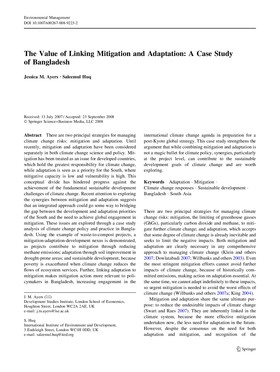The Value of Linking Mitigation and Adaptation: A Case Study of Bangladesh

There are two principal strategies for managing climate change risks: mitigation and adaptation. Until recently, mitigation and adaptation have been considered separately in both climate change science and policy. Mitigation has been treated as an issue for developed countries, which hold the greatest responsibility for climate change, while adaptation is seen as a priority for the South, where mitigative capacity is low and vulnerability is high. This conceptual divide has hindered progress against the achievement of the fundamental sustainable development challenges of climate change. Recent attention to exploring the synergies between mitigation and adaptation suggests that an integrated approach could go some way to bridging the gap between the development and adaptation priorities of the South and the need to achieve global engagement in mitigation. These issues are explored through a case study analysis of climate change policy and practice in Bangladesh
Cite this publication
Available at https://www.iied.org/g02370